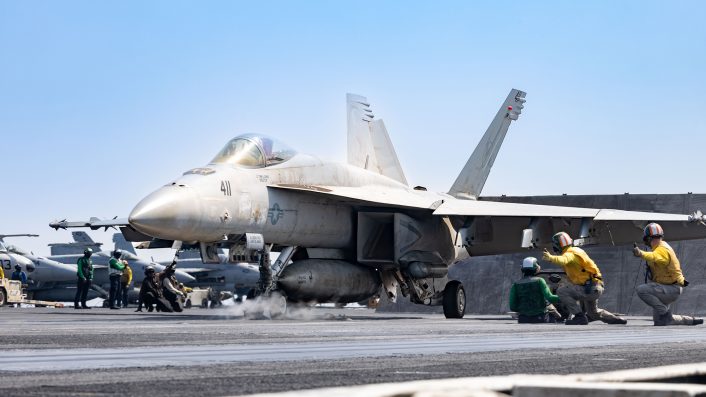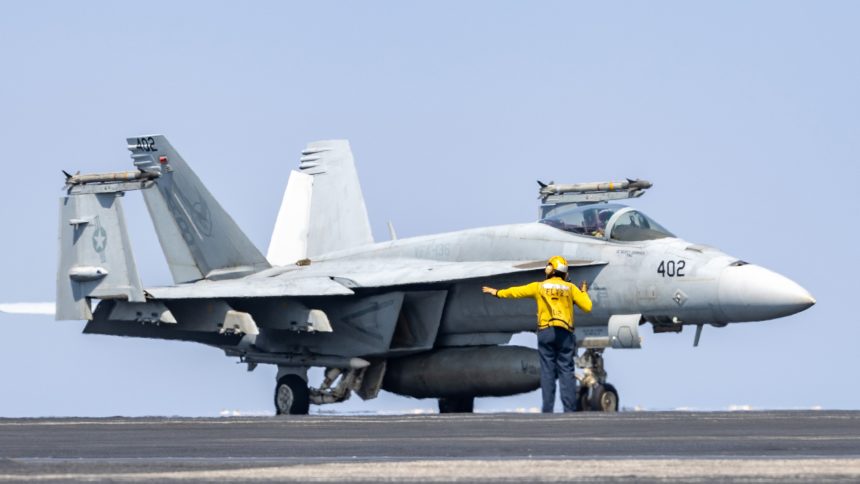USS Harry S. Truman (CVN 75) lost an F/A-18E Super Hornet along with a tow tractor. All personnel have been accounted for, and one Sailor suffered a minor injury.
While operating in the Red Sea on April 28, USS Harry S. Truman (CVN 75) lost an F/A-18E Super Hornet from Strike Fighter Squadron (VFA) 136 along with a tow tractor. All personnel have been accounted for, and one Sailor suffered a minor injury.
According to a press release by the U.S. Navy, the F/A-18E was being towed in the hangar bay when the move crew lost control of the aircraft, resulting in both the Super Hornet and the tow tractor going overboard.
Sailors involved in the tow operation quickly moved clear of the area before the aircraft fell into the sea. An investigation into the incident is currently underway.
Despite the loss, the Harry S. Truman Carrier Strike Group and its embarked air wing remain fully mission capable, the Navy says.
According to some unconfirmed reports, the jet fell overboard as the carrier performed a sharp turn to evade Houthi fire.
VERY interesting: The U.S. Navy lost a $60 million F-18 jet at sea after it fell overboard from the USS Harry S. Truman, reportedly during a sharp turn to evade Houthi fire.
Source: CNN https://t.co/3xbkhmW6yl
— Clash Report (@clashreport) April 28, 2025
The strike group includes flagship USS Harry S. Truman, the nine squadrons of Carrier Air Wing 1, three guided-missile destroyers assigned to Destroyer Squadron 28, and the Ticonderoga-class guided-missile cruiser USS Gettysburg (CG 64).
If this is confirmed, this incident would highlight the risks of operating in contested waters like the Red Sea, a key trade route. The Houthis, an Iran-backed group, have been targeting U.S. assets amid ongoing tensions. The loss of the $60 million jet raises questions about carrier vulnerabilities and may push the U.S. to rethink naval defense strategies against such threats.
IMPORTANT: IFTruman had to make a sudden hard turn to avoid enemy fire this is extremely significant. The goal for US troops is to always bring down the enemy as far away as possible NOT close in. And this potentially suggests further improvements in Houthi guidance and… https://t.co/W7f11tvrrJ
— Barbara Starr (@bstarrreports) April 28, 2025
Similar incident in 2022
Interestingly, the somewhat bizarre incident reminds another one involving USS Truman: on Jul. 8, 2022, an F/A-18E Super Hornet belonging to Carrier Air Wing 1 aboard USS Truman sailing in the Mediterranean Sea, blew off the flight deck of the aircraft carrier due to very bad weather. The mishap was not related to the aircraft going overboard during flying activity but it occurred as the carrier was hit by “an unexpected brief period of intense winds and heavy rains”. No one was aboard the F/A-18E at the time of the incident. One sailor was injured in the mishap.
Aircraft handling is the biggest driver of Navy mishaps. From a deep dive I did a few months ago: https://t.co/JaxuE1LWOV pic.twitter.com/N3cBXG44vl
— Brian Everstine (@beverstine) April 28, 2025
A few weeks later, the U.S. Navy announced that aircraft was successfully recovered from a depth of approximately 9,500 feet on Aug. 3, 2022, by a team from Task Force (CTF) 68, Naval Sea Systems Command’s Supervisor of Salvage and Diving (SUPSALV), Harry S. Truman, Naval Strike Fighter Wing Atlantic, and U.S. Sixth Fleet embarked on the multi-purpose construction vessel (MPV) Everest. The aircraft was recovered using a CURV-21 remotely operated vehicle to attach specialized rigging and lift lines to the aircraft. A lifting hook was attached to the rigging to raise the aircraft to the surface and hoist it aboard Everest.

Not the first mishap during the current deployment
This is not the first mishap involving USS Harry S. Truman and its assets.
The nuclear powered aircraft carrier began its current deployment in September 2024 and has ventured across Europe as well as into the Red Sea. It has been a fairly dramatic deployment, with the ship taking a leading role in Operation Prosperity Guardian against Houthi rebels in Yemen. Notably, during combat operations in December 2024 one of Truman’s F/A-18F Super Hornets was downed by U.S. Navy cruiser USS Gettysburg (CG 64) in a widely reported friendly fire incident.
USS Truman was involved in a collision with the merchant vessel Besiktas-M on Feb. 12, 2025, while operating in the vicinity of Port Said, Egypt, in the Mediterranean Sea. The collision did not endanger the carrier however, a U.S. Navy assessment revealed damage to two storage rooms on board the ship, alongside a maintenance space, line handling space, an exterior platform, and the fantail.

After Emergent Repair Availability (ERAV) was conducted on the ship’s damaged sections in Souda Bay, Crete, Capt. Dave Snowden, commanding officer of USS Harry S. Truman (CVN 75), was relieved on Feb. 20, 2025, “due to a loss of confidence in his ability to command,” the U.S. Navy 6th Fleet Public Affair announced.
“The U.S. Navy holds commanding officers to the highest standard and takes action to hold them accountable when those standards are not met. Naval leaders are entrusted with significant responsibilities to their Sailors and their ships,” said the U.S. Navy.
Capt. Christopher “Chodaw” Hill, commanding officer of USS Dwight D. Eisenhower (CVN 69), serves as Harry S. Truman’s interim commanding officer since then.
Following the repairs, the aircraft carrier took a central role in the large-scale operation against Houthi targets in Yemen, launched after U.S. President Donald Trump vowed to use “overwhelming lethal force” to stop any threat to international shipping posed by the rebel group on Mar. 15, 2025. The strikes saw Super Hornets departing the USS Truman armed with standoff weapons, specifically the AGM-154C Joint Stand-Off Weapon (JSOW) and the AGM-84H/K SLAM-ER (Standoff Land Attack Missile-Expanded Response) in what was a first in the air campaign against the Houthis: previous strikes were mainly performed with 1,000 lb GBU-32 JDAM bombs. Some of the aircraft were also equipped with AGM-88E AARGMs (Advanced Anti-Radiation Guided Missile).
🇺🇲 Super Hornets armed with JSOWs. https://t.co/3TC4kKIn17 pic.twitter.com/AObRdlznQy
— Guy Plopsky (@GuyPlopsky) March 15, 2025









